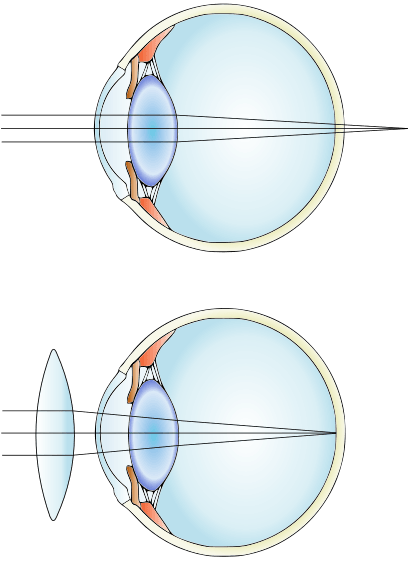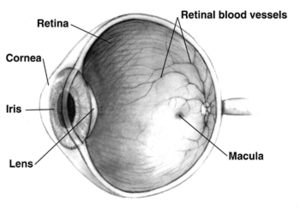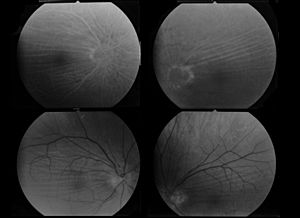Far-sightedness facts for kids
Quick facts for kids Far-sightedness |
|
|---|---|
| Synonyms | Hypermetropia, hyperopia, longsightedness, long-sightedness |
 |
|
| Far-sightedness without (top) and with lens correction (bottom) | |
| Symptoms | Near blur, Distance and near blur, Asthenopia |
| Complications | Accommodative dysfunction, binocular dysfunction, amblyopia, strabismus |
| Causes | Axial length of eyeball is too short, lens or cornea is flatter than normal, aphakia |
| Risk factors | Ageing, hereditary |
| Diagnostic method | Eye exam |
| Similar conditions | Amblyopia, retrobulbar optic neuropathy, retinitis pigmento sine pigmento |
| Treatment | Eyeglasses, contact lenses, refractive surgeries, IOL implantation |
| Frequency | ~7.5% (US) |
Far-sightedness, also called long-sightedness or hyperopia, is an eye condition. It means that you can see objects far away clearly. However, objects that are close to you look blurry. This happens because light entering your eye focuses behind your retina, not directly on it. The retina is like the screen at the back of your eye that sends images to your brain.
Young people with mild far-sightedness might not notice it. Their eyes can often adjust to make things clear. But this extra effort can cause eye strain, especially when reading for a long time. If far-sightedness is severe, both near and distant objects can appear blurry. It can also lead to other eye issues like amblyopia (lazy eye) or strabismus (crossed eyes). Most babies are born a little far-sighted, but this usually improves as they grow.
This condition can happen for several reasons. Your eyeball might be too short from front to back. Or, the lens or cornea (the clear front part of your eye) might be too flat. Other causes include changes in the lens or if the lens is missing. Things that increase your risk include family history, diabetes, certain medicines, and growths near the eye. Far-sightedness is a type of refractive error, which means your eye doesn't bend light correctly. An eye exam is used to diagnose it.
Far-sightedness can be managed with eyeglasses, contact lenses, or eye surgery. Glasses are the easiest option. Contact lenses offer a wider view. Surgery changes the shape of your cornea. Far-sightedness is common in young children. It affects about 8% of 6-year-olds but only 1% of 15-year-olds. It becomes more common again after age 40, a condition called presbyopia.
Other common refractive errors include near-sightedness and astigmatism.
Contents
Signs and Symptoms
When you are young, mild far-sightedness might not cause any problems. But common signs and symptoms include blurry vision, headaches (often in the front of your head), and eye strain. Your eyes might feel tired. A main symptom is often eye strain. You might also have trouble seeing with both eyes together (binocular vision) or judging distances. These symptoms, especially blurry vision up close, often get worse after doing close work, like reading, especially in the evening.
Eye Problems from Far-sightedness
Far-sightedness can sometimes lead to problems like strabismus (crossed eyes) and amblyopia (lazy eye). If a child has severe far-sightedness at a young age, their eyes might "over-focus." This can sometimes cause them to see double.
Adults with very short eyeballs due to far-sightedness have a higher risk of developing a type of glaucoma called primary angle closure glaucoma. Because of this, adults with far-sightedness should have regular eye checks for glaucoma.
What Causes Far-sightedness?
The most common type of far-sightedness, called simple hyperopia, happens because of normal differences in how eyeballs develop. Here are the main reasons why far-sightedness occurs:
- Eyeball Length: If your eyeball is too short, light focuses behind the retina. For example, if the eyeball is about 1 millimeter shorter than it should be, it can cause about 3 diopters of far-sightedness.
- Cornea or Lens Shape: If the cornea (the clear front part of your eye) or the lens inside your eye is flatter than normal, light won't bend enough. This also makes light focus behind the retina.
- Changes in the Lens: Sometimes, changes in the lens itself, like those that happen with age or conditions like diabetes, can cause far-sightedness.
- Lens Position: If the lens moves out of its normal position, it can also lead to far-sightedness. This can happen due to an injury.
- After Eye Surgery: Sometimes, far-sightedness can happen after eye surgery for other conditions, like if surgery for near-sightedness corrects too much.
- Muscle Problems: In rare cases, problems with the eye muscles that help your eye focus can cause far-sightedness.
- Missing Lens: If someone is born without a lens, or if their lens is removed (for example, due to a severe injury), it causes a very high degree of far-sightedness.
Far-sightedness is often present from birth. However, children's eye lenses are very flexible. This helps them to naturally adjust and see clearly. In rare cases, far-sightedness can be linked to conditions like diabetes or problems with the blood vessels in the retina.
How is Far-sightedness Diagnosed?
An eye doctor diagnoses far-sightedness during an eye exam. They use special tools to measure how your eye focuses light. This can involve a retinoscope or an automated refractor. They might also use different lenses in a trial frame or a phoropter to find the best prescription for you.
The doctor may also use a slit lamp test. This tool lets them look closely at the front parts of your eye, like the cornea, conjunctiva, and iris. This helps them check for any unusual structures or problems.
If a baby has severe far-sightedness from birth, their brain might have trouble combining the blurry images from each eye. This can make it hard for the child to learn to see things in detail. If the brain never learns to see clearly, one eye might become dominant. The brain then starts to ignore the blurry signals from the other eye. This is different from near-sightedness, where children can see close objects clearly and learn to see details early on.
How Far-sightedness is Grouped
Far-sightedness is often grouped based on how it appears or how severe it is.
Types of Far-sightedness
There are three main types:
- Simple hyperopia: This is the most common type. It happens naturally because of normal differences in how eyes develop.
- Pathological hyperopia: This type is caused by a disease, an injury, or abnormal development of the eye.
- Functional hyperopia: This is rare and happens when the eye's ability to focus is paralyzed, often due to nerve problems.
How Severe is It?
Far-sightedness is also grouped by how strong the prescription needed is:
- Low: This means the refractive error is +2.00 diopters (D) or less.
- Moderate: This is when the refractive error is between +2.00 D and +5.00 D.
- High: This means the refractive error is greater than +5.00 D.
Treatment
The goal of treatment is to help light focus correctly on your retina.
Corrective Lenses
The easiest way to treat far-sightedness is by using corrective lenses. These can be eyeglasses or contact lenses. Glasses for far-sightedness have convex lenses, which are thicker in the middle. These lenses help to bend light more, so it focuses correctly on your retina.
Surgery
There are also surgical options to correct far-sightedness:
Laser Procedures These surgeries use lasers to change the shape of your cornea. This helps light focus better on your retina.
- Photorefractive keratectomy (PRK): This removes a tiny amount of the cornea's surface. It can have some side effects like blurry vision during healing.
- Laser assisted in situ keratomileusis (LASIK): This is a common laser eye surgery. It reshapes the cornea so you might not need glasses or contact lenses anymore. LASIK can correct moderate far-sightedness.
- Laser epithelial keratomileusis (LASEK): Similar to PRK, but uses alcohol to loosen the corneal surface before reshaping.
- Epi-LASIK: This procedure is also used to correct far-sightedness and avoids using alcohol.
- Laser thermal keratoplasty (LTK): This uses a laser to heat and reshape the cornea. It's used for mild far-sightedness.
IOL Implantation (Lens Implants) These procedures involve placing an artificial lens inside your eye.
- Aphakia correction: If someone has very high far-sightedness because their natural lens is missing (a condition called aphakia), an IOL (intraocular lens) implant is often the best solution.
- Refractive lens exchange (RLE): This is like cataract surgery. The natural lens is replaced with an artificial one to correct a high refractive error.
- Phakic IOL: These are artificial lenses implanted inside the eye without removing your natural lens. They can correct very high levels of far-sightedness.
Non-Laser Procedures These methods also reshape the cornea but don't use lasers.
- Conductive keratoplasty (CK): This uses radiofrequency energy to heat and shrink corneal tissue. It's used for mild far-sightedness and presbyopia.
- Automated lamellar keratoplasty (ALK): This is an older surgical method for far-sightedness. It's not used as much now because it can be less predictable.
- Keratophakia and epi-keratophakia: These are other older surgical techniques for high far-sightedness. They can sometimes cause irregular astigmatism.
Word Origin
The word hyperopia comes from ancient Greek. "Hyper" means "over" and "ops" means "sight." So, it means "over-sight" or seeing too far.
See also
 In Spanish: Hipermetropía para niños
In Spanish: Hipermetropía para niños




